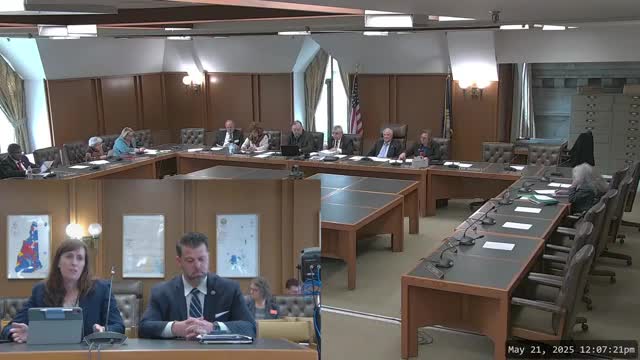Insurance department advances ambulance rate compromise to prohibit balance billing
May 21, 2025 | Commerce and Consumer Affairs, House of Representatives, Committees , Legislative, New Hampshire
This article was created by AI summarizing key points discussed. AI makes mistakes, so for full details and context, please refer to the video of the full meeting. Please report any errors so we can fix them. Report an error »

In a pivotal meeting held on May 21, 2025, the New Hampshire House Commerce and Consumer Affairs Committee addressed a long-standing issue that has plagued the state’s emergency medical services (EMS) sector: balance billing. Under the soft glow of city hall lights, legislators and stakeholders gathered to discuss a compromise aimed at stabilizing the financial landscape for ambulance providers while protecting consumers from unexpected medical bills.
The meeting revealed that the House's proposed rate structure, set at 202% of Medicare, was significantly lower than the Senate's benchmark of 325%. After extensive negotiations, a compromise emerged, prohibiting balance billing and establishing a temporary rate structure for two years. This structure includes a tiered system with an in-network rate of $3.25 and an out-of-network rate of $1.00, designed to incentivize providers to join insurance networks.
Key to this agreement is the introduction of an "any willing provider" provision, allowing any ambulance service willing to accept the contract terms to join the network, thereby preventing insurance companies from excluding them unilaterally. This move aims to ensure that consumers have access to emergency services without the fear of surprise billing.
The compromise also includes a commitment to conduct a second cost study, which will delve deeper into the financial realities faced by EMS providers. This study is expected to take a year and a half, allowing for broader stakeholder engagement and a more accurate assessment of costs associated with providing services to commercially insured individuals.
As the meeting progressed, representatives expressed concerns about the complexities of the contracting process and the potential delays in finalizing agreements. To address these issues, the insurance department will develop a streamlined form for providers to initiate the in-network rate, ensuring that negotiations remain active and transparent.
The discussions underscored the urgency of the situation, with some EMS providers struggling to remain financially viable. The compromise aims not only to protect consumers from unexpected costs but also to stabilize the EMS network, which is crucial for public safety.
In closing, the committee acknowledged the historical challenges surrounding balance billing and the need for a sustainable solution. For the first time in four decades, a framework has been established that seeks to balance the interests of consumers, providers, and insurers, paving the way for a more equitable healthcare system in New Hampshire. As the two-year period unfolds, all eyes will be on the outcomes of the cost study and the effectiveness of the new rate structure in addressing the systemic issues facing the EMS industry.
The meeting revealed that the House's proposed rate structure, set at 202% of Medicare, was significantly lower than the Senate's benchmark of 325%. After extensive negotiations, a compromise emerged, prohibiting balance billing and establishing a temporary rate structure for two years. This structure includes a tiered system with an in-network rate of $3.25 and an out-of-network rate of $1.00, designed to incentivize providers to join insurance networks.
Key to this agreement is the introduction of an "any willing provider" provision, allowing any ambulance service willing to accept the contract terms to join the network, thereby preventing insurance companies from excluding them unilaterally. This move aims to ensure that consumers have access to emergency services without the fear of surprise billing.
The compromise also includes a commitment to conduct a second cost study, which will delve deeper into the financial realities faced by EMS providers. This study is expected to take a year and a half, allowing for broader stakeholder engagement and a more accurate assessment of costs associated with providing services to commercially insured individuals.
As the meeting progressed, representatives expressed concerns about the complexities of the contracting process and the potential delays in finalizing agreements. To address these issues, the insurance department will develop a streamlined form for providers to initiate the in-network rate, ensuring that negotiations remain active and transparent.
The discussions underscored the urgency of the situation, with some EMS providers struggling to remain financially viable. The compromise aims not only to protect consumers from unexpected costs but also to stabilize the EMS network, which is crucial for public safety.
In closing, the committee acknowledged the historical challenges surrounding balance billing and the need for a sustainable solution. For the first time in four decades, a framework has been established that seeks to balance the interests of consumers, providers, and insurers, paving the way for a more equitable healthcare system in New Hampshire. As the two-year period unfolds, all eyes will be on the outcomes of the cost study and the effectiveness of the new rate structure in addressing the systemic issues facing the EMS industry.
View full meeting
This article is based on a recent meeting—watch the full video and explore the complete transcript for deeper insights into the discussion.
View full meeting
